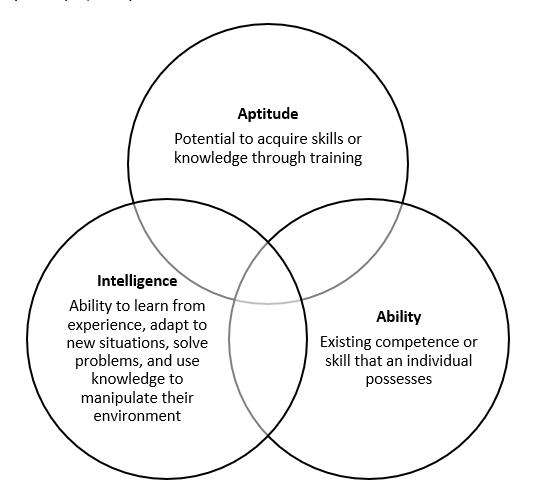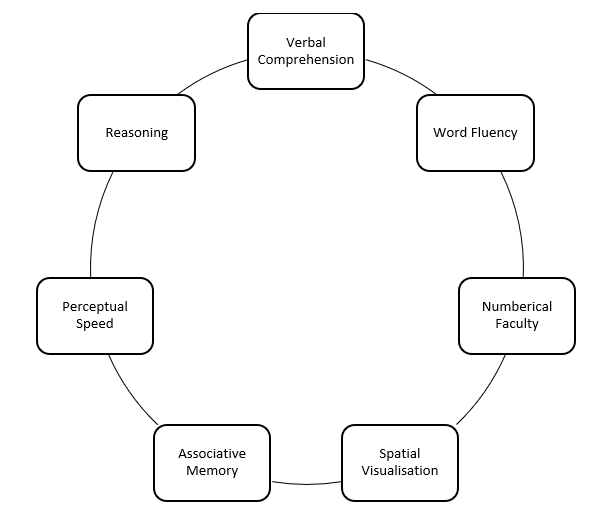Purpose of DBDA-R
To measure the primary ability factors (Verbal, Numerical, Spatial, Closure, Clerical, Mechanical, psycho-motor and Reasoning Ability) of respondent using DBDA-R by M. Kapoor.
Publication year: 1994.
AGE RANGE: 13 – 30 Years
ADMINISTRATION: Group/Individual
TIME: 60 minutes
Introduction of DBDA-R
American psychological Associations (APA) defined ability as existing competence or skill to perform a specific physical or mental act. Although ability may be either innate or developed through experience, it is distinct from capacity to acquire competence
What is Aptitude?
Aptitude is defined as “a condition or a set of characteristics regarded as symptomatic of an individual’s ability to acquire with training some (usually specified) Knowledge, skill or set of responses such as the ability to speak a language, to produce music.” (Bennett, Seashore, & Wesman, 1982)
Super (1949): “Aptitude is a condition symptomatic of a person’s relative fitness, of which one essential aspect is his readiness to acquire proficiency – his potential ability – and another is his readiness to develop an interest in exercising that ability.”
Hahn & MacLean (1955): “Aptitudes are correctly referred to as latent potentialities, undeveloped capacities to acquire abilities and skills and to demonstrate achievements. Aptitudes, thus, may be briefly regarded as potentialities which can be trained into special skills.
APA defined aptitude as the capacity to acquire competence or skill through training. Specific aptitude is potential in a particular area (e.g., artistic or mathematical aptitude); general aptitude is potential in several fields. Both are distinct from ability, which is an existing competence.
Aptitude vs Ability vs Intelligence
Aptitude, ability, and intelligence are distinct yet interrelated concepts in psychology. Aptitude refers to an individual’s potential to acquire skills or knowledge through training. It is seen as a latent ability that can be developed with the right education or experience. Bennett, Seashore, and Wesman (1982) define aptitude as characteristics that indicate an individual’s capacity to acquire skills, such as language proficiency or musical talent. Super (1949) further described aptitude as a condition indicative of a person’s readiness to acquire proficiency and develop interest in exercising that ability. Hahn & MacLean (1955) considered aptitudes as latent potentialities that, with training, can transform into specific skills.
On the other hand, ability is an existing competence or skill that an individual possesses. According to the American Psychological Association (APA), ability is the competence to perform a specific physical or mental task, which can be either innate or developed through experience.
Ability is distinct from capacity because it represents actual skills rather than the potential to acquire them. Intelligence is a complex and multifaceted construct that has been studied extensively in psychology. It refers to an individual’s ability to learn from experience, adapt to new situations, solve problems, and use knowledge to manipulate their environment. Different theories and models have emerged to explain the nature of intelligence, ranging from those that emphasize a single, overarching ability to those that identify multiple, independent mental faculties.

Ability vs Aptitude vs Intelligence
- Spearman g-factor theory
Charles Spearman (1904) saw intelligence as two different abilities. The ability to reason and solve problems was labelled g factor for general intelligence, and task-specific abilities in certain areas such as music, business, or art are labelled s factor for specific intelligence. A traditional IQ test would most likely measure g factor, but Spearman believed that superiority in one type of intelligence predicts superiority overall.
- Thurstone’s theory of primary mental abilities
It was developed in the 1930s, challenged the idea of a single “general intelligence” factor. Thurstone believed intelligence wasn’t one thing, but a combination of independent mental skills. He used factor analysis to identify seven primary mental abilities:
- Verbal Comprehension: Understanding spoken and written language.
- Word Fluency: Generating words quickly (e.g., naming animals).
- Number Facility: Skills in math and calculations.
- Spatial Visualization: Imagining and manipulating objects in 3D space.
- Associative Memory: Linking ideas and remembering associations.
- Perceptual Speed: How quickly you identify details and process information.
- Reasoning: Solving problems logically and drawing conclusions.
People have a unique mix of these abilities, contributing to their overall intelligence.

Primary Mental Abilities
This theory paved the way for modern intelligence tests that assess specific cognitive skills rather than a single intelligence score.
- Guilford’s Structure-of-Intellect (SI) Model:
Intelligence is made up of many independent mental abilities, not just one. He gave three dimensions of intelligence. These included-
- Operations: how we process information (e.g., remembering, evaluating)
- Contents: what type of information we process (e.g., visual, semantic)
- Products: the outcome of processing (e.g., identifying units, forming relationships)
The SI model has up to 180 possible abilities by combining these dimensions. It highlights individual differences in various intellectual strengths and weaknesses. It faces the criticism that it is complex and may not have full empirical support for all abilities. Despite this, it is influential in understanding intelligence and developing broader assessments.
- Vernon’s Structure of Human Abilities or Hierarchical Group Factor Theory
It builds upon the concept of a general intelligence factor (“g” factor) but further divides cognitive abilities into specific groups.
It has a Hierarchical Structure i.e. Intelligence is organized hierarchically, with the “g” factor at the top representing a general ability that underlies all cognitive tasks. It also has Group Factors i.e. beneath the “g” factor lie two broad group factors-
- Verbal-educational (v:ed)- Encompasses abilities related to language, vocabulary, and academic skills.
- Perceptual-motor-mechanical (k:m)- Includes abilities related to spatial reasoning, manual dexterity, and mechanical skills.
Vernon acknowledged the possibility of a third, separate factor specific to mathematical abilities, but considered it potentially subsumed within the k:m factor.
Overall, Vernon’s model suggests that while a general intelligence factor contributes to performance across various cognitive tasks, specific abilities within the verbal-educational and perceptual-motor-mechanical domains also play a significant role.
The abilities that are measured in DBDA-R are-
- Verbal ability– Verbal Ability refers to the comprehension of words and ideas. Or a person’s ability to understand written language. Sub-tests: Part-I – vocabulary and Part-II: understanding proverbs
- Numerical ability – Numerical Ability refers to the facility in manipulating numbers quickly and accurately, in tasks involving mathematical operations (addition, subtraction, multiplication, division, etc.).
- Spatial ability- Spatial Ability is concerned with perceiving spatial patterns accurately, and following the orientation of figures when their position in a space is altered
- Closure ability (CA)- Closure Ability is primarily refers to the ability to see quickly a whole stimulus when parts of it are missing or to complete the gestalt.
- Clerical ability- Clerical Ability is perceptual activity primarily concerned with making rapid evaluations of features of visual stimuli.
- Reasoning ability- Reasoning Ability refers to the ability to apply the process of induction or to reason from some specific information to a general principle.
- Mechanical ability- Mechanical Ability refers to an understanding of basic mechanical principles, simple machines, tools, electrical, and automotive facts.
- Psycho-motor ability- Psycho-motor Ability refers to precise movements requiring eye-hand coordination under highly speeded conditions.
Psychometric Properties of DBDA-R
Reliability Of DBDA-R
The DBDA-R manual reports good internal consistency reliability coefficients for all subtests, typically ranging from .70 to .90. This indicates that the subtests consistently measure the same underlying abilities across different administrations. However, it’s important to consult the manual for specific reliability coefficients for each subtest and different age groups.
Validity of DBDA-R
The DBDA-R demonstrates construct validity through its theoretical foundation and evidence that the subtests measure distinct cognitive abilities. Studies have shown correlations between DBDA-R subtests and other established measures of similar abilities.
Concurrent validity is also supported by findings showing correlations between DBDA-R scores and academic performance and job performance in relevant fields.
Predictive validity evidence is limited, but some studies suggest that DBDA-R scores may be somewhat predictive of future academic and job success.
Norms of DBDA-R
The DBDA-R provides age-normed scores and Education STEN scores based on a representative sample of individuals from different age groups. These norms allow for interpretation of individual scores in relation to the performance of others in the same age group.
Sample:
- School students
- College students
- Normal adults
Test Material for DBDA-R
- Handbook for DBDA-revised
- 2 Question booklet
- Answer sheet
- Scoring Stencil
- Ability Graph Sheet
Administration Of DBDA-R

Administration Time
* Time not to be disclosed to the subject
Scoring And Interpretation of DBDA-R
- The stencil given is placed above the score sheet.
- The answers that are circled are the correct answers.
- The client gains, ‘1’ point for every correct answer.
- The scores are added in every category and then the Sten score is found out using norms table
- The plot the graph by using the Sten score sheet.
Generally, a Sten score of 1,2 or 3 is indicative of a lower level of ability.
A Sten score of 4, 5, 6 or 7 is indicative of an average level of ability.
A score range from 8 to 10 indicates a high level of skills in the particular ability domain.
Sten Scores and its Interpretations-

Sten Score
Sample Results and Discussion of DBDA-R
Name: ABC
Age: 18 years

Interpretation Table
Overall Discussion:
ABC’s DBDA-R scores reveal a well-rounded cognitive profile with above average strengths in Verbal Ability, Spatial Ability, and Clerical Ability. These strengths suggest potential for success in fields like communication, design, or administration. While his scores in other areas fall within the average range, targeted interventions or educational strategies could help him develop his Numerical, Reasoning, and Mechanical abilities if he pursues careers in those fields.
Here are some additional points to consider:
- It is important to remember that these are just sample results, and individual scores can vary significantly.
- A qualified professional should interpret the DBDA-R results in the context of the student’s background, interests, and academic performance.
- The DBDA-R should not be the sole factor in making decisions about a student’s educational or career path. Other factors, such as personality, motivation, and interests, should also be taken into account.
By understanding his cognitive strengths and weaknesses as identified by the DBDA-R, Rahul can make informed decisions about his academic and career goals and explore suitable educational or training options to help him achieve his full potential.
Applications of DBDA-R
- Education settings -To help students considering the next steps of their educational options, such as choosing major course at college or university.
- Career counsellor – To help the client to decide the most suitable career for himself based on his level of ability
- Industrial settings – It is even used for appropriate selection of applicants for employment.
References
Hahn, M.E., & MacLean, M.S. (1955). Counselling Psychology. McGraw-Hill Book Company, Inc., New York, 2nd
Reynolds, C. R. (2014). David’s Battery of Differential Abilities-Revised (DBDA-R). Psychological Assessment Resources, Inc.
Super, D.E. (1949). The psychology of careers. Harper & Brothers
Dr. Balaji Niwlikar. (2024, March 7). DBDA-R- David’s Battery Of Differential Abilities-Revised- Master Measuring 8 Types of Abilities. Careershodh. https://www.careershodh.com/dbda-r/

Hi, I would like to have the David Battery of different abilities Questionnaire for my psychology students
Please send us email on careershodh@gmail.com
Please add your contact number & address and other details to get quotation.